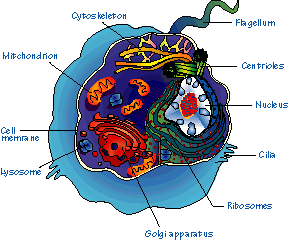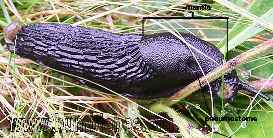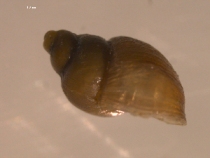
Classification
Domain- Eukarya
Kingdom- Animalia
Phylum-
Mollusca
Class- Gastropoda
(Subclass- Pulmonata)
Order- Basommatophora
Family- Lymnaeidae
Genus- Fossaria
Species- Fossaria parva
(Encyclopedia
of Life)

Organisms, like F. parva, in the
domain Eukarya possess cells that have a membrane bound nucleus/nuclei
and organelles, for the word "eukarya" means "truly nuclear". (Eisenhour, 2009).
(The picture to the right shows a typical eukaryotic cell).
The kingdom Animalia, which is
simply translated to “animal”, is also sometimes referred to “Metazoa”.
Eukaryotes placed in this kingdom are multicellular (Eisenhour,
2009).
Animals found in the phylum Mollusca
are bilateral (have one line of body symmetry), have three
tissue layers (also called "tripoblastic") and have a “soft body”, which
is the group’s distinctive characteristic (and literal
translation of the word) (Eisenhour, 2009).
The literal translation from Latin of Gastropoda is “stomach-foot”, which is indicative of how all
molluscs in this class move. Other characteristics that
classify organisms as gastropods are that they develop through a trochophore and/or veliger larval stage, have a well-developed
head containing a radula and usually have a coiled shell
(although some species have lost their shells completely) (Eisenhour,
2009).
 Gastropods that are placed in the
subclass Pulmonata lack an operculum, have replaced gills with
an lung-like air sack in the mantle cavity and tend
to be most of the land and freshwater snails and slugs (Eisenhour,
2009).
Gastropods that are placed in the
subclass Pulmonata lack an operculum, have replaced gills with
an lung-like air sack in the mantle cavity and tend
to be most of the land and freshwater snails and slugs (Eisenhour,
2009).
(The picture to the left shows a slug with this modification)
Pulmonates that belong to the order
Basommatophora have eyes that are at the base of their tentacles
instead of at the tip (Dillon, 2000).
Basommatophores that are classified
into the family Lymnaeidae have dextral shells that have medium
to high spire (Dillon, 2000).
Up until about 1970, the genus
Fossaria was part of a larger genus called Lymnaea.
Due to developments in research, the genus was divided into
several genera, including Fossaria, which are smaller
than other organisms in their family (Clifford,
1991).

Fossaria parva is
translated to “pigmy fossaria”, which is the snail’s common
name. The organism got its name due to the fact that it is the
smallest of its genus (Clifford,
1991).
(The picture to the right show the shell
of the Fossaria parva).